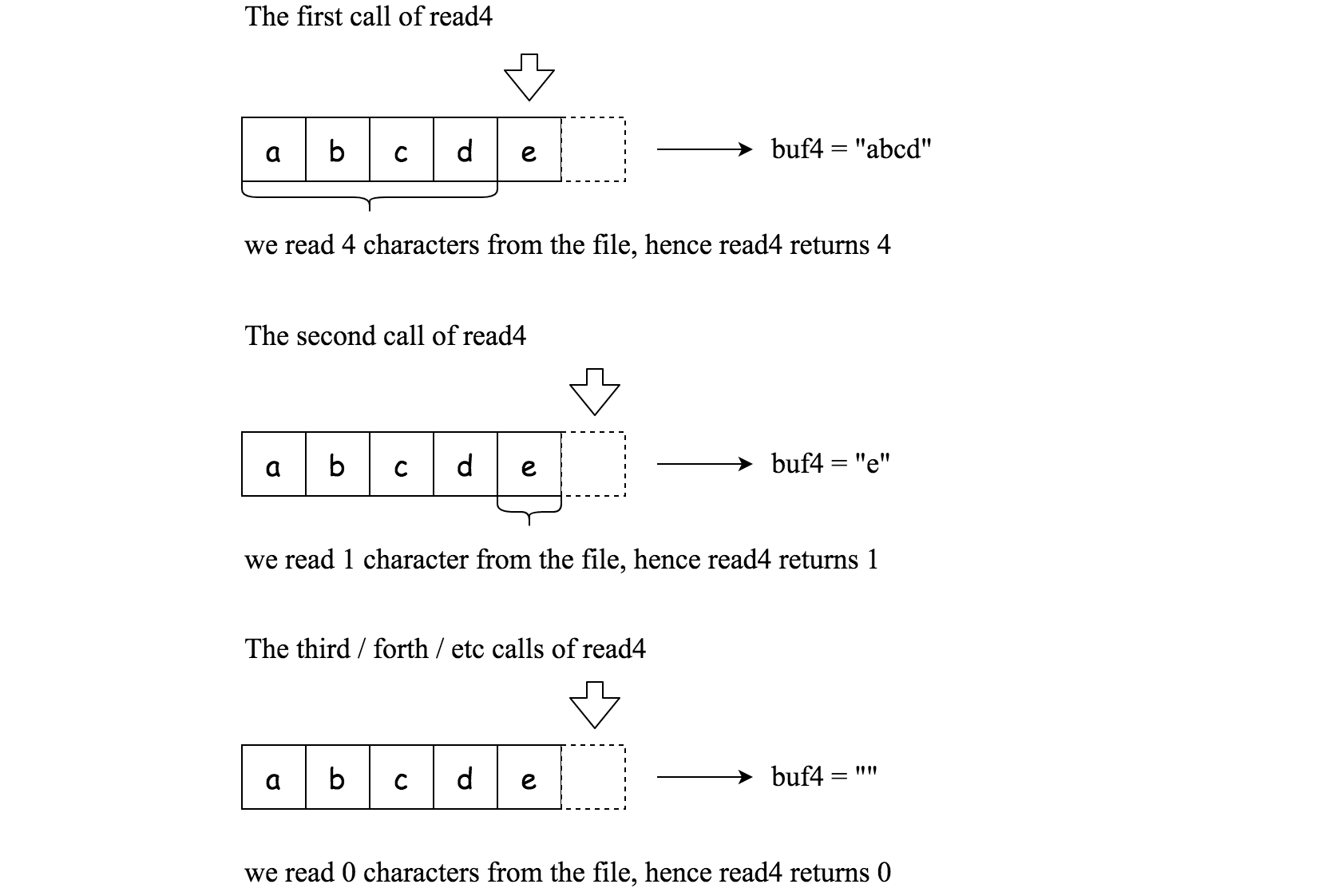给你一个文件,并且该文件只能通过给定的 read4 方法来读取,请实现一个方法使其能够读取 n 个字符。注意:你的 read 方法可能会被调用多次。
read4 的定义:
read4 API 从文件中读取 4 个连续的字符,然后将这些字符写入缓冲区数组 buf4 。
返回值是读取的实际字符数。
请注意,read4() 有其自己的文件指针,类似于 C 中的 FILE * fp 。
参数类型: char[] buf4
返回类型: int
注意: buf4[] 是目标缓存区不是源缓存区,read4 的返回结果将会复制到 buf4[] 当中。
下列是一些使用 read4 的例子:

File file(“abcde”); // 文件名为 “abcde”, 初始文件指针 (fp) 指向 ‘a’
char[] buf4 = new char[4]; // 创建一个缓存区使其能容纳足够的字符
read4(buf4); // read4 返回 4。现在 buf4 = “abcd”,fp 指向 ‘e’
read4(buf4); // read4 返回 1。现在 buf4 = “e”,fp 指向文件末尾
read4(buf4); // read4 返回 0。现在 buf4 = “”,fp 指向文件末尾
read 方法:
通过使用 read4 方法,实现 read 方法。该方法可以从文件中读取 n 个字符并将其存储到缓存数组 buf 中。您 不能 直接操作文件。
返回值为实际读取的字符。
read 的定义:
参数: char[] buf, int n
返回值: int
注意: buf[] 是目标缓存区不是源缓存区,你需要将结果写入 buf[] 中。
示例 1:
File file(“abc”);
Solution sol;
// 假定 buf 已经被分配了内存,并且有足够的空间来存储文件中的所有字符。
sol.read(buf, 1); // 当调用了您的 read 方法后,buf 需要包含 “a”。 一共读取 1 个字符,因此返回 1。
sol.read(buf, 2); // 现在 buf 需要包含 “bc”。一共读取 2 个字符,因此返回 2。
sol.read(buf, 1); // 由于已经到达了文件末尾,没有更多的字符可以读取,因此返回 0。
示例 2:
File file(“abc”);
Solution sol;
sol.read(buf, 4); // 当调用了您的 read 方法后,buf 需要包含 “abc”。 一共只能读取 3 个字符,因此返回 3。
sol.read(buf, 1); // 由于已经到达了文件末尾,没有更多的字符可以读取,因此返回 0。
提示:
- 你 不能 直接操作该文件,文件只能通过 read4 获取而 不能 通过 read。
- read 函数可以被调用 多次。
- 请记得 重置 在 Solution 中声明的类变量(静态变量),因为类变量会 在多个测试用例中保持不变,影响判题准确。请 查阅 这里。
- 你可以假定目标缓存数组 buf 保证有足够的空间存下 n 个字符。
- 保证在一个给定测试用例中,read 函数使用的是同一个 buf。
来源:力扣(LeetCode)
链接:https://leetcode-cn.com/problems/read-n-characters-given-read4-ii-call-multiple-times
思路:
因为read需要从上一次read结束的地方继续read,所以需要保存read4缓存区,上次已读取的偏移,以及上次的缓存区大小。
复杂度分析:
时间复杂度O(n)
空间复杂度O(1)
var solution = function (read4) {/*** @param {character[]} buf Destination buffer* @param {number} n Number of characters to read* @return {number} The number of actual characters read*/let buffer = [];let readOffset = 0;let bufferSize = 0;const getNextChar = () => {if (readOffset === bufferSize) {bufferSize = read4(buffer);readOffset = 0;if (bufferSize === 0) {return 0;}}return buffer[readOffset++];};return function (buf, n) {for (let i = 0; i < n; i++) {let next = getNextChar();if (next === 0) {return 0;} else {buf[i] = next;}}return n;};};

